Humminbird 385ci Combo Owner's Manual
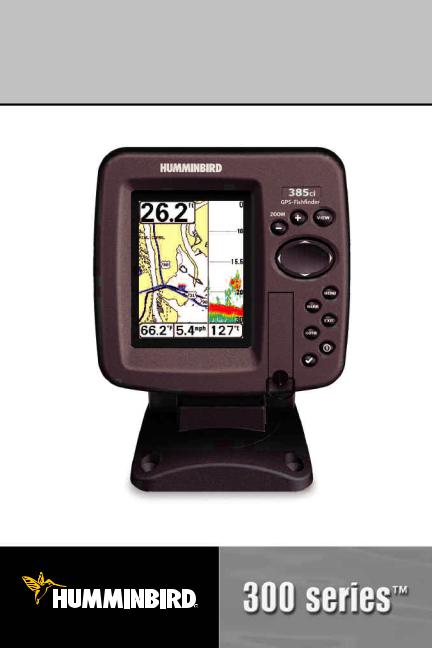
385ci Combo Operations Manual
531730-1_A

Thank You!
Thank you for choosing Humminbird®, America’s #1 name in fishfinders. Humminbird® has built its reputation by designing and manufacturing top-quality, thoroughly reliable marine equipment. Your Humminbird® is designed for trouble-free use in even the harshest marine environment. In the unlikely event that your Humminbird® does require repairs, we offer an exclusive Service Policy - free of charge during the first year after purchase, and available at a reasonable rate after the one-year period. For complete details, see the separate warranty card included with your unit. We encourage you to read this operations manual carefully in order to get full benefit from all the features and applications of your Humminbird® product.
To contact our Customer Resource Center, call 1-800-633-1468 or visit our web site at www.humminbird.com.
WARNING! This device should not be used as a navigational aid to prevent collision, grounding, boat damage, or personal injury. When the boat is moving, water depth may change too quickly to allow time for you to react. Always operate the boat at very slow speeds if you suspect shallow water or submerged objects.
WARNING! Disassembly and repair of this electronic unit should only be performed by authorized service personnel. Any modification of the serial number or attempt to repairthe original equipment or accessories by unauthorized individualswill void the warranty.
WARNING! This product contains chemicals known to the State of California to cause cancer and/or reproductive harm.
WARNING! Do not travelat high speed with the unit coverinstalled.Remove the unit cover before traveling at speeds above 20 mph.
NOTE: Some features discussed in this manual require a separate purchase, and some featuresare only available on international models. Every efforthas been made to clearly identify those features. Please read the manual carefully in order to understand the full capabilities of your model.
ENVIRONMENTAL COMPLIANCE STATEMENT: It is the intentionof Humminbird®to be a responsible corporate citizen, operating in compliance with known and applicable environmentalregulations, and a good neighbor in the communities where we make or sell our products.

WEEE DIRECTIVE: EU Directive2002/96/EC “Wasteof Electricaland ElectronicEquipment Directive (WEEE)” impacts most distributors, sellers, and manufacturers of consumer electronics in the European Union. The WEEE Directive requires the producer of consumer electronics to take responsibility for the management of waste from their products to achieve environmentally responsible disposal during the product life cycle.
WEEE compliance may not be required in your locationfor electrical & electronicequipment (EEE), nor may it be required for EEE designed and intended as fixed or temporary installation in transportation vehicles such as automobiles, aircraft, and boats. In some European Union member states, these vehicles are consideredoutside of the scope of the Directive, and EEE for those applications can be considered excluded from the WEEE Directive requirement.
This symbol (WEEE wheelie bin) on product indicates the product must not be disposed of with other household refuse. It must be disposed of and collectedfor recycling and recovery of waste EEE. Humminbird® will mark all EEE products in accordance with the WEEE Directive. It is our goal to comply in the collection, treatment, recovery, and environmentally sound disposalof those products;however, these requirements do vary within European Union member states. For more information about where you should dispose of your waste equipment for recyclingand recovery and/or your European Union member state requirements, please contact your dealer or distributorfrom
which your product was purchased.
ROHS STATEMENT: Product designed and intended as a fixed installation or part of a system in a vessel may be considered beyond the scope of Directive 2002/95/EC of the European Parliament and of the Council of 27 January 2003 on the restrictionof the use of certain hazardous substances in electrical and electronicequipment.
ATTENTION INTERNATIONAL CUSTOMERS: Products sold in the U.S. are not intended for use in the international market. Humminbird® internationalunits provide international features and are designed to meet country and regional regulations. Languages, maps, time zones, units of measurement, and warranty are examples of features that are customized for Humminbird® international units purchased through our authorized international distributors.
To obtain a list of authorized international distributors, please visit our web site at www.humminbird.com or contact our Customer ResourceCenter at (334) 687-6613.
Navionics® Gold, HotMaps™, and HotMaps™ Premium are registered trademarks of Navionics®. 300 Series™, DualBeam PLUS™, Fish ID+™, Humminbird®, RTS™, RTS Window™, Structure ID®, SwitchFire™, WhiteLine™, UniMap™, and X-Press™ Menu are trademarked by or registered trademarks of Humminbird®.
© 2009 Humminbird®, Eufaula AL, USA. All rights reserved.

Table of Contents |
|
Power On the Unit |
1 |
How Sonar Works |
2 |
DualBeam PLUS™ Sonar .......................................................................................... |
4 |
How GPS Works |
5 |
What’s On the Sonar Display |
6 |
Understanding the Sonar Display ............................................................................ |
8 |
Real Time Sonar (RTS™) Window ............................................................................ |
8 |
SwitchFire™ ............................................................................................................ |
9 |
Freeze Frame and Active Cursor............................................................................... |
9 |
Instant Image Update.............................................................................................. |
9 |
Bottom Presentation.............................................................................................. |
10 |
Views |
12 |
Sonar View ............................................................................................................ |
14 |
Sonar Zoom View .................................................................................................. |
15 |
200/83 kHz Split Sonar View ................................................................................. |
16 |
Big Digits View ...................................................................................................... |
17 |
Circular Flasher View ............................................................................................ |
18 |
Snapshot and Recording View............................................................................... |
19 |
Bird’s Eye View ...................................................................................................... |
25 |
Chart View.............................................................................................................. |
26 |
Chart/Sonar Combo View........................................................................................ |
28 |
View Orientation.................................................................................................... |
29 |
Viewing Cartography ............................................................................................ |
29 |
Introduction to Navigation |
32 |
Waypoints, Routes, and Tracks ............................................................................. |
32 |
Save, Edit, or Delete a Waypoint ........................................................................... |
34 |
Navigate to a Waypoint or Position ........................................................................ |
36 |
Add a Waypoint Targetor Trolling Grid .................................................................. |
37 |
Save, Edit, or Delete a Route ................................................................................. |
38 |
Save or Clear a Current Track................................................................................. |
39 |
i

Table of Contents |
|
Edit, Delete, or Hide Saved Tracks........................................................................ |
39 |
Add Maps to Your Fishfinder ............................................................................... |
40 |
Export NavigationData......................................................................................... |
41 |
What’s on the 300 Series™ Control Head |
42 |
Key Functions |
43 |
POWER/LIGHT Key ............................................................................................. |
43 |
VIEW Key ............................................................................................................. |
43 |
INFO Key ............................................................................................................... |
44 |
MENU Key ........................................................................................................... |
44 |
4-WAY Cursor Control Key ................................................................................. |
44 |
MARK Key............................................................................................................. |
45 |
GOTO Key............................................................................................................... |
46 |
ZOOM (+/-) Key..................................................................................................... |
46 |
EXIT Key ............................................................................................................... |
46 |
Multi-Media Card (MMC)/SD Slot |
47 |
The Menu System |
48 |
Start-Up Options Menu |
49 |
Normal................................................................................................................... |
49 |
Simulator ............................................................................................................. |
50 |
System Status ..................................................................................................... |
50 |
Self Test................................................................................................................. |
51 |
Accessory Test....................................................................................................... |
51 |
GPS Diagnostic View ........................................................................................... |
52 |
X-Press™ Menu |
53 |
Main Menu |
54 |
Quick Tips for the Main Menu .................................................................................. |
55 |
Note for all Menu Settings .......................................................................................... |
55 |
User Mode (Normal or Advanced) .............................................................................. |
56 |
ii

Table of Contents |
|
Sonar X-Press™ Menu (Sonar views only) |
58 |
Sensitivity ................................................................................................................ |
59 |
Upper Range (Advanced: Sonar, Split Sonar, Circular Flasher, |
|
and Big Digits Views only) ........................................................................................ |
60 |
Lower Range .......................................................................................................... |
60 |
Chart Speed ............................................................................................................ |
61 |
Bottom Range (Sonar Zoom View only when Bottom Lock is On) .................................... |
61 |
Bottom Lock (Sonar Zoom View only) .......................................................................... |
62 |
Cancel Navigation (only when navigating) .................................................................. |
62 |
Navigation X-Press™ Menu (Navigation views only) |
63 |
Waypoint [Name] (only with an active cursor on a waypoint)........................................ |
64 |
Cursor To Waypoint (Chart or Combo View only) ........................................................ |
64 |
Save Current Track .................................................................................................. |
64 |
Clear Current Track .................................................................................................. |
65 |
Save Current Route (only when Navigating) .............................................................. |
65 |
Skip Next Waypoint (only when Navigating) .............................................................. |
65 |
Cancel Navigation (only when Navigating) ................................................................ |
65 |
Remove Target (only if Target is Active) ...................................................................... |
65 |
Remove Grid (only if Grid is Active).............................................................................. |
66 |
Sonar Window (Combo View only).............................................................................. |
66 |
Waypoint [Name] (Most recently-created waypoint) .................................................... |
66 |
Snapshot and Recording X-Press™ Menu |
|
(Snapshot and Recording View only) |
67 |
Start Recording (optional-purchase MMC/SD Card, Snapshot and |
|
Recording View only) ...................................................................................................... |
68 |
Stop Recording (optional-purchase MMC/SD Card only) ................................................ |
68 |
Delete Image (optional-purchase MMC/SD Card, Snapshot |
|
and Recording View only) .............................................................................................. |
68 |
Delete All Images (optional-purchase MMC/SD Card, Snapshot |
|
and Recording View only) .............................................................................................. |
68 |
Delete Recording (optional-purchase MMC/SD Card, Snapshot |
|
and Recording View only) ................................................................................................ |
69 |
iii

Table of Contents |
|
Delete All Recordings (optional-purchase MMC/SD Card, Snapshot |
|
and Recording View only).............................................................................................. |
69 |
Pings Per Second (optional-purchase MMC/SD Card, Snapshot |
|
and Recording View only).............................................................................................. |
69 |
Playback Speed (optional-purchase MMC/SD Card, Snapshot |
|
and Recording View only).............................................................................................. |
70 |
Stop Playback (optional-purchase MMC/SD Card only) ................................................ |
71 |
Alarms Menu Tab |
72 |
Depth Alarm ......................................................................................................... |
73 |
Fish ID Alarm......................................................................................................... |
73 |
Low Battery Alarm ............................................................................................... |
73 |
Temp. Alarm ......................................................................................................... |
74 |
Off Course Alarm ................................................................................................. |
74 |
Arrival Alarm ......................................................................................................... |
75 |
Drift Alarm............................................................................................................. |
75 |
Alarm Tone ........................................................................................................... |
75 |
Sonar Menu Tab |
76 |
Beam Select ......................................................................................................... |
77 |
Surface Clutter ..................................................................................................... |
78 |
SwitchFire™ ......................................................................................................... |
78 |
Fish ID+™ ............................................................................................................. |
79 |
Fish ID Sensitivity ................................................................................................. |
80 |
Real Time Sonar (RTS™) Window ........................................................................ |
80 |
Bottom View ......................................................................................................... |
81 |
Zoom Width ......................................................................................................... |
81 |
83 kHz Sensitivity (Advanced).................................................................................. |
81 |
Depth Lines (Advanced) .......................................................................................... |
82 |
Noise Filter (Advanced) ............................................................................................ |
82 |
Max Depth (Advanced) ............................................................................................ |
83 |
Water Type (Advanced) ............................................................................................ |
83 |
iv

Table of Contents |
|
Navigation Menu Tab |
84 |
Current Track .......................................................................................................... |
85 |
Saved Tracks .......................................................................................................... |
85 |
Waypoints .............................................................................................................. |
86 |
Routes ..................................................................................................................... |
87 |
Chart Orientation.................................................................................................... |
87 |
North Reference .................................................................................................... |
87 |
Waypoint Decluttering (Advanced)............................................................................ |
88 |
Grid Rotation .......................................................................................................... |
88 |
Trackpoint Interval.................................................................................................. |
88 |
Track Min Distance (Advanced) ................................................................................ |
89 |
Map Datum (Advanced) ............................................................................................ |
89 |
Course Projection Line ........................................................................................... |
89 |
Export All Nav Data................................................................................................ |
89 |
Delete All Nav Data (Advanced) ................................................................................ |
90 |
Continuous Navigation Mode ............................................................................... |
90 |
Chart Menu Tab |
91 |
Chart Detail Level .................................................................................................. |
92 |
Map Borders .......................................................................................................... |
92 |
Lat/Lon Grid............................................................................................................ |
93 |
Spot Soundings...................................................................................................... |
93 |
Navaids on Bird’s Eye View ................................................................................... |
93 |
Shaded Depth ........................................................................................................ |
93 |
Chart Select............................................................................................................ |
93 |
Set Simulation Position (Advanced) ...................................................................... |
94 |
Set Map Offset (Advanced) .................................................................................... |
94 |
Clear Map Offset (Advanced) ................................................................................ |
94 |
v

Table of Contents |
|
Setup Menu Tab |
95 |
Units - Depth......................................................................................................... |
96 |
Units - Temp (International only) .............................................................................. |
96 |
Units - Distance ................................................................................................... |
96 |
Units - Speed ....................................................................................................... |
96 |
User Mode ........................................................................................................... |
97 |
Language (International only).................................................................................... |
97 |
Triplog Reset ....................................................................................................... |
97 |
Restore Defaults ................................................................................................... |
97 |
Select Readouts (Advanced, Sonar View only) .......................................................... |
98 |
Depth Offset (Advanced).......................................................................................... |
99 |
Temp. Offset (Advanced).......................................................................................... |
99 |
Speed Calibration (Advanced, with Temp/Speed only) .............................................. |
99 |
Local Time Zone (Advanced).................................................................................... |
99 |
Daylight Saving Time (Advanced).......................................................................... |
100 |
Position Format (Advanced) .................................................................................. |
100 |
Time Format (Advanced, International only) ............................................................ |
100 |
Date Format (Advanced, International only).............................................................. |
100 |
NMEA Output (Advanced) .................................................................................... |
101 |
Sonar ................................................................................................................... |
101 |
Screen Snapshot................................................................................................. |
102 |
Views Menu Tab |
103 |
Troubleshooting |
104 |
Fishfinder Doesn’t Power Up .............................................................................. |
104 |
Fishfinder Defaults to Simulator with a Transducer Attached.......................... |
104 |
Display Problems ............................................................................................... |
105 |
Finding the Cause of Noise ............................................................................... |
106 |
vi

Table of Contents
300 Series™ Fishfinder Accessories |
107 |
Specifications |
108 |
Glossary |
109 |
Contact Humminbird® |
117 |
NOTE: Entries in this Table of Contents which list (International Only) are only available on products sold outside of the U.S. by our authorized international distributors. To obtain a list of authorized international distributors, please visit our web site at www.humminbird.com or contact our Customer Resource Center at
(334) 687-6613.
NOTE: Entries in this Table of Contents which list (with Temp/Speed only) require the purchas e of separate accessories. You can visit our web site at www.humminbird.com to order these accessories online or contact our Customer Resource Center at 1-800-633-1468.
NOTE: Some features discussed in this manual require a separate purchase, and some features are only available on international models. Every effort has been made to clearly identify those features. Please read the manual carefully in order to understand the full capabilities of your model.
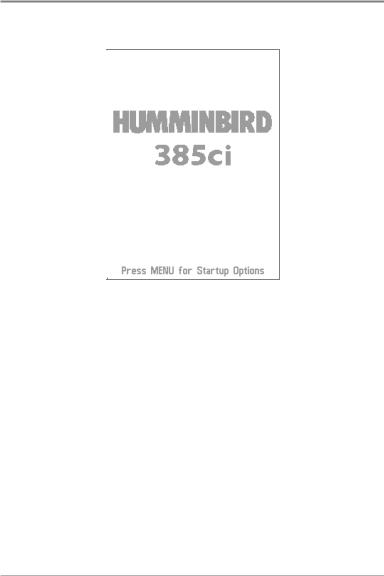
Power On the Unit
Follow the instructions below to power on your Humminbird® control head.
385ci Combo Title Screen
1.Press the  POWER/LIGHT key.
POWER/LIGHT key.
2.When the Title screen is displayed, press the MENU key to access the Start-Up Options Menu.
3.Use the 4-WAY Cursor Control key to select Normal (if there is a transducer attached to the control head), or Simulator (if there isn’t a transducer attached to the control head).
NOTE: See Start-Up Options Menu for more information.
•If a functioning transducer is connected, Normal operation will be selected automatically at power up, and your Fishfinder can be used on the water.
•If a transducer is not connected and you wait too long to select a Start-Up Option, the system will default to whichever menu is already highlighted.
•In Simulator you can learn how to use your control head and save settings in advance for later use.
1 |
Power On the Unit |

How Sonar Works
Sonar technology is based on sound waves. The 300 Series™ Fishfinder uses sonar to locate and define structure, bottom contour and composition, as well as depth directly below the transducer.
Your 300 Series™ Fishfinder sends a sound wave signal and determines distance by measuring the time between the transmission of the sound wave and when the sound wave is reflected off of an object; it then uses the reflected signal to interpret location, size, and composition of an object.
Sonar is very fast. A sound wave can travel from the surface to a depth of 240 ft (70 m) and back again in less than 1/4 of a second. It is unlikely that your boat can “outrun“ this sonar signal.
SONAR is an acronym for SOund and NAvigation Ranging. Sonar uses precision sound pulses or “pings“ which are emitted into the water in a teardrop-shaped beam.
The sound pulses “echo“ back from objects in the water such as the bottom, fish, and other submerged objects. The returned echoes are displayed on the LCD screen. Each time a new echo is received, the old echoes are moved across the LCD, creating a scrolling effect.
How Sonar Works |
2 |
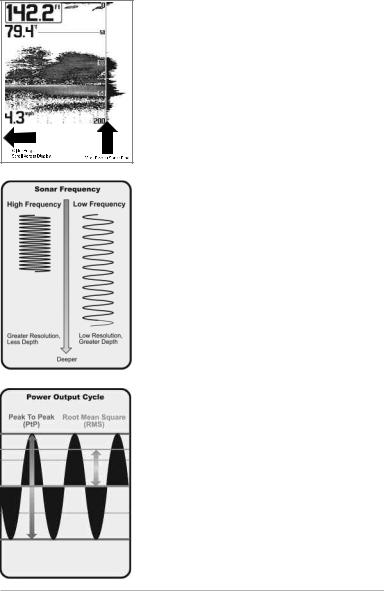
When all the echoes are viewed side by side, an easy to interpret “graph“ of the bottom, fish, and structure appears.
The sound pulses are transmitted at various frequencies depending on the application. Very high frequencies (455 kHz) are used for greatest definition but the operating depth is limited. High frequencies (200 kHz) are commonly used on consumer sonar and provide a good balance between depth performance and resolution. Low frequencies (83 kHz) are typically used to achieve greater depth capability.
The power output is the amount of energy generated by the sonar transmitter. It is commonly measured using two methods:
•Root Mean Square (RMS) measures power output over the entire transmit cycle.
•Peak to Peak measures power output at the highest points.
The benefits of increased power output are the ability to detect smaller targets at greater distances, ability to overcome noise, better high speed performance and enhanced depth capability.
3 |
How Sonar Works |

DualBeam PLUS™ Sonar
Your 300 Series™ Fishing System uses a 200/83 kHz DualBeam PLUS™ sonar system with a wide (60°) area of coverage. DualBeam PLUS™ sonar has a narrowly focused 20° center beam, surrounded by a second beam of 60°, expanding your coverage to an area equal to your depth. In 20 feet of water, the wider beam covers an area 20 feet wide. DualBeam PLUS™ sonar returns can be blended together, viewed separately, or compared side-by-side. DualBeam PLUS™ is ideal for a wide range of conditions - from shallow to very deep water in both fresh and salt water. Depth capability is affected by such factors as boat speed, wave action, bottom hardness, water conditions and transducer installation.
How Sonar Works |
4 |

How GPS Works
Your 300 Series™ Fishfinder also supports GPS (Global Positioning System) and chartplotting. It uses GPS and sonar to determine your position, display it on a grid, and provide detailed underwater information.
GPS uses a constellation of satellites that continually send radio signals to the earth. The GPS receiver on your boat receives signals from satellites that are visible to it. Based on time differences between each received signal, the GPS receiver determines its distance to each satellite. With distances known, the GPS receiver mathematically triangulates its own position. With once per second updates, the GPS receiver then calculates its velocity and bearing.
GPS was originally intended for military use; however, civilians may also take advantage of its highly accurate position capabilities, typically within +/- 4.5 meters, depending on conditions. This means that 95% of the time, the GPS receiver will read a location within 4.5 meters of your actual position. Your GPS Receiver also uses information from WAAS (the Wide Area Augmentation System), EGNOS (the European Geostationary Navigation Overlay Service), and MSAS (the MTSAT Satellite Augmentation System) satellites if they are available in your area.
The following GPS functionality is currently supported by the 300 Series™ Fishfinder when it is connected to the included GPS receiver:
•View current position
•View current track (breadcrumb trail)
•View precision speed and heading from your GPS receiver
•Save tracks, waypoints, and routes
•Travel a route and navigate from one waypoint to the next.
See Chart View and Introduction to Navigation: Add Maps to Your Fishfinder for more information.
5 |
How GPS Works |
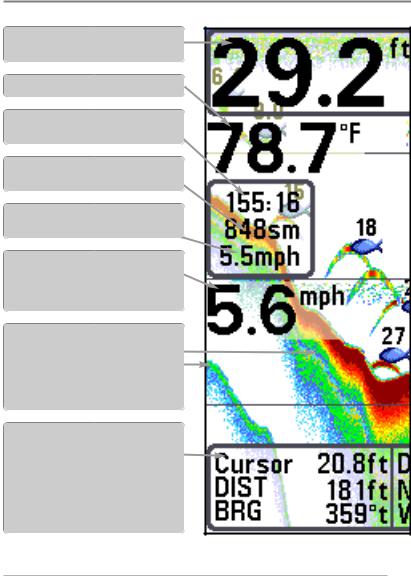
What’s on the Sonar Display
The 300 Series™ Fishfinder can display a variety of useful information about
Depth - Waterdepth; can be set to alarm when the water becomestoo shallow.
Temperature - Water surfacetemperature.
Timer - Elapsed time with Temp/Speed
Accessory or GPS Receiver.
Distance - Distance traveled with Temp/Speed
Accessory or GPS Receiver.
Average Speed - Average speed reading with
Temp/Speed Accessory or GPS Receiver.
Speed - If a Temp/Speed accessory or GPS Receiver is attached, the Fishfinder can display the speed of the boat and can keep a Triplog of nautical or statutemiles traveled.
Second Sonar Return - When the sonar signal bouncesbetweenthebottomand thesurface ofthe water and backagain. Use the appearance of the second returnto determine bottomhardness. Hard bottomswillshowa strongsecondreturn,whilesoft bottomswillshowa veryweakone ornoneat all.
Cursor Dialog Box - Indicates cursor depth on the display and the depth of the bottom directly below the cursor. The Latitude and Longitude of the cursor position, the distance to travel to the cursor position, and the bearing to the cursor position are shown with a GPS receiver. A waypoint can be marked at the cursor position for later retrieval and use with a GPS receiver.
NOTE: Entries in this view that list (with Temp/Speed or GPS Receiver) are available if either the information from the GPS receiver will be displayed on the view.
What’s on the Sonar Display |
6 |

the area under your boat, including the following items:
High Sonar Intensity Return
Bait Ball
Fish - The Fishfinder displays fish as arches and/or fish icons, and can be set to alarm when a fish of a certain size is detected. When a target is detected, a Fish ID+™ symbol appears on the display with the depth displayed above it. The size of the symbol indicates the intensity of the sonar return. The unit will clearly show schools of Bait Fish as "clouds" of different shapes and sizes, depending on the number of fish and boat speed.
Thermoclines - Layers of water with different temperatures that appear at different depths and different times of the year. A thermocline typically appears as a continuous band of many colors moving across the display at the same depth.
Cursor - Available in Freeze Frame and can be positioned in the Sonar View to provide depth of a sonar return and bottomdepthbelow the cursor.
RTS (Real Time Sonar) Window™
Structure - Wherefish may be hiding.
Low Sonar Intensity Return
device is connected to the 300 Series™ Fishfinder. If both devices are connected, then only
7 |
What’s on the Sonar Display |

Understanding the Sonar Display
It is im portant to understand the significance of the display. The d isplay d oes n ot sh ow a literal 3-dimensional representation of wh at is under the water. Each vertical band of data received by the c ontrol he ad a nd plo tted o n the d isplay represents something t hat was detected by a sonar return at a particular time. As both the boat and the targets (fish) may be moving, the returns are o nly sh owing a p articular s egment of time when o bjects w ere detec ted, n ot exactly where those o bjects a re in r elation to o ther objects shown on the display.
The returned sonar echoes ar e displa yed on the screen. As a new ec ho is received, the historical data scrolls left across the view.
Real Time Sonar (RTS™) Window
A Real Time Sonar (RTS™) Window appears on the right side of the display in the Sonar View only. The RTS Window™ updates at the fastest rate possible for depth conditions and shows only the returns from the bottom, structure, and fish that are within the transducer beam . The RTS Wind ow™ plots the depth and intensity of a sonar return (see Sonar Menu Tab: RTS Window™).
The Narrow RTS Window™ indicates the sonar intensity through the use of colors. Red indicates a strong return and blue indicates a weak return. The depth of the sonar return is indicated by t he ver tical placement of the return on the display depth scale.
The Wide R TS W indow™ indicates t he so nar i ntensity through the u se of a ba r graph. The length of the plotted r eturn indicates whether the return is weakor strong. The depth of the sonar return is in dicated by th e vertical p lacement of th e return o n the d isplay d epth
scale. The Wide RT |
S |
Window™ does n ot us |
e |
grayscale. |
|
What’s on the Sonar Display |
8 |

SwitchFire™
SwitchFire™ controls how the sonar returns are displayed in the Sonar Views. SwitchFire™ settings are available in the Sonar Menu Tab.
To see the maximum sonar information available within the transducer beam so more fish arches and better jig tracking are shown, choose Max Mode.
To see less clutter and more fish size accuracy interpreted from the transducer beam, cho ose Clear Mode. See Sonar Menu Tab: Switch Fire™ for more information.
Freeze Frame and Active Cursor
Freeze Frame & Active Cursor - Press any arrow on the 4-WAY Cursor Control key, and the screen will freeze and a cursor will be displayed. Use the 4-WAY Cursor Control key to m ove the cursor over a sonar return, and the depth of the sonar return will be displayed at the bottom ofthe screen in the cursor dialog box.
The RTS Window™ continues to update in Freeze Frame. To return to a scrolling display and exit Freeze Frame,press the EXIT key. Freeze Frame is available in the
Sonar, Split Sonar, and Sonar Zoom Views.
Instant Image Update
Instant Image Update - You can change a variety of sonar menu settings (such as Sensitivity or Upper Range), and the adjustments will be shown instantly on the screen.
9 |
What’s on the Sonar Display |
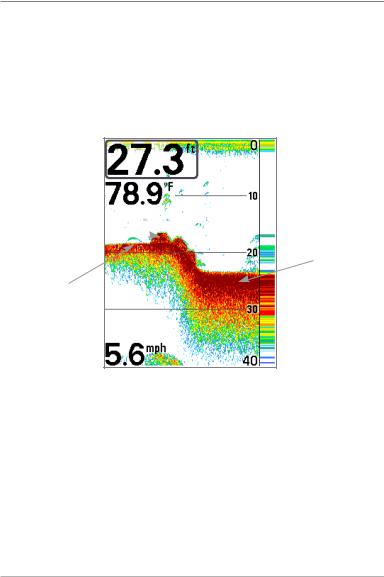
Bottom Presentation
As the boat moves, the unit charts the changes in depth on the display to create a profile of the Bottom Contour. The type of b ottom can be d etermined from the return charted on the display. A Hard Bottom such as compacted sediment or flat rock appears as a thinner line across the display. A Soft Bottom such as mud or sand appears as a thicker line across the display. Rocky Bottoms have a broken, random appearance.
Bottom Contour Profile with RTS Window™
Rocky Bottom
Soft Bottom
Hard Bottom
The sonar returns from the bott om, structure, and fish can be represented as
WhiteLine™ or Structure ID®. See Sonar Menu Tab: Bottom View to set the bottom view.
What’s on the Sonar Display |
10 |
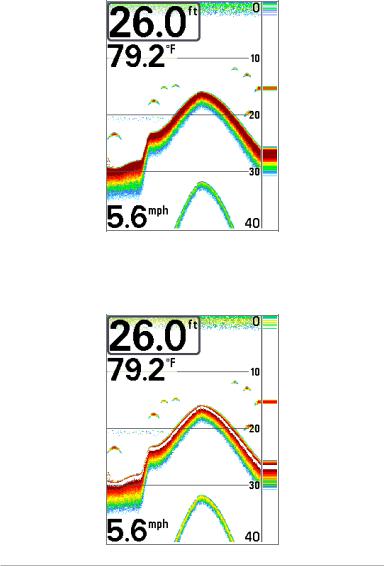
Structure ID® represents weak returns in blue and strong returns in red.
WhiteLine™ highlights t he st rongest s onar retur ns in white, r esulting in a distinctive outline. This has the benefit of clearly defining t he bottom on the display.
11 |
What’s on the Sonar Display |
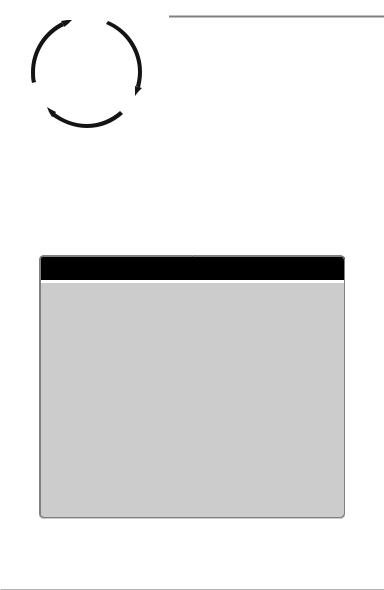
|
Bird ’s E ye |
|
||||
GPSSDiaiagnostnostst icc |
|
|
Vie w |
Chaartt |
||
Vi ieww |
|
|
|
|
|
Vi iew |
Acccesesosorryyy |
|
|
|
|
|
Combobo |
Vieww |
|
|
|
|
|
Vi iew |
Selflf |
|
|
|
|
|
Soonaarr |
Testt |
|
|
|
|
|
Vieww |
|
|
|
|
|
|
|
Snaapsshotaot andd |
|
|
|
|
|
Soonaarr Zoomm |
ReecoordingVding View |
|
|
|
|
|
Vi ieww |
Ci irculcularrFlFlassherer |
|
|
|
|
|
Spl litt Soonarar |
Vieeww |
Bigg Diggittss |
Vi iew |
||||
|
|
|||||
|
|
|
Viewew |
|
||
Views
The sonar and navigation information from your Fishfinder are displayed on the screen in a variety of easy-to-read views. There are many v iews av ailable on you r F ishfinder. When you press the VIEW key, the display cycles through the available views on your screen. When you press the EXIT k ey, the display cycles through the available views in reverse order.
When you first power up the control head, Sonar View will be the default view. You can display and hide any view to suit your fishing preferences.
NOTE: When you change any menu settings that affect the sonar,the view will update immediately. Youdon't have to exit the menu to apply the change to the screen.
Sonar views: |
Navigation views: |
Sonar View |
Bird’s Eye View |
Sonar Zoom View |
Chart View |
200/83 kHz Split Sonar View |
Chart/Sonar Combo View |
Big Digits View |
GPS Diagnostic View |
(see Start-Up Options Menu)
Circular Flasher View
Snapshot and Recording View
Self Test View
(see Start-Up Options Menu)
Accessory Test View
(see Start-Up Options Menu)
Details about each view are available on the following pages.
Views |
12 |

To customize your view rotation:
You can choose which views are hidden or visible in your view rotation.
1.Press the M ENU key t wice t o acc ess th e tab bed Main Menu, then press the RIGHT Cursor key until the Views tab is selected.
2.Press the UP or DOWN Cursor keys to select a View.
3.Press the LEFT or RIGHT Cursor keys to change the status of the view from Hidden to Visible or vice versa.
To change the Digital Readouts:
Each view displays digital readout information (such as sp eed or time), which varies with the view selected, the accessory attached, and whether or not you are navigating. The digital readouts on the Sonar View can be customized. See
Setup Menu Tab: Select Readouts for more information.
1.Press the M ENU key t wice t o acc ess th e tab bed Main Menu, then press the RIGHT Cursor key until the Setup tab is selected.
2.Press the DOWN key to highlight Select Readouts, and press the RIGHT Cursor key to access the Select Readouts submenu.
NOTE: If the Select Readouts option does not appear under the Setup Tab, change the User Mode to Advanced.
3.Press the UP or DOWN Cursor keys to select a Readout position, then press the RIGHT or LEFT Cursor keys to choose what will be displayed in that position. To hide the data window, select Off. (Course, Navigation, Off, Position, Speed, Temperature, Time+Date, Triplog, Voltage, Time)
13 |
Views |

Sonar View
Sonar View presents a historical log of sonar returns. The most recent sonar returns a re chart ed on t he right side of the display. As ne w informa tion is received, the historical information scrolls left across the display.
•Upper and Lower Depth Range numbers indicate the distance from the surface of the water to a depth range sufficient to show the bottom.
•Depth is automatically selected to keep the bottom visible on the display, although you can adjust it manually as well (see Sonar X-Press™ Menu).
•Digital Readouts shown on the display will change based on the Select Readouts settings or the optional-purchase accessories attached (see
Setup Menu Tab: Select Readouts).
•Freeze Frame - Use the 4-WAY Cursor Control key to freeze the display and move the cursor over a sonar return. The depth of the sonar returnwill be displayed at the bottom of the screen in the cursor dialog box.
Sonar View
Depth |
|
Upper Depth |
|
Range |
|
|
|
Temperature 
Cursor
Triplog
Speed
 RTS Window™
RTS Window™
Sonar History
Window
Cursor
Dialog Box
NOTE: If the Depth number is flashing, it means that the unit is having trouble locating the bottom. This usually happens if the water is too deep, the transducer isout of the water, theboat is moving too fast, or for any other reason that the unit can’t accurately receive continuous data.
Views |
14 |
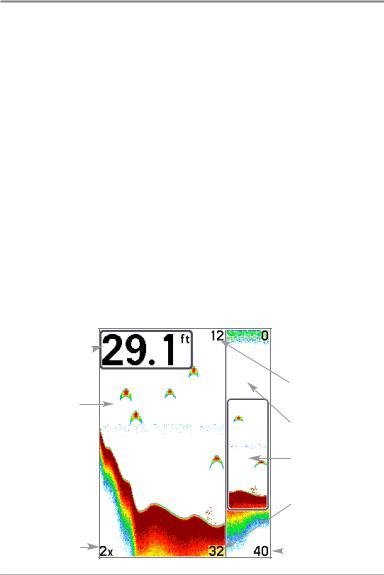
Sonar Zoom View
Sonar Zoom View provides a magnified view of the bottom and structure. The Sonar Zoom View makes it easier to see sep arate so nar return s that would usually be displayed close together, such as t hose caused by fish su spended close to the bottom or within structure.
•The Zoom Level, or magnification, is displayed in the lower left corner of the display. Press the + or - ZOOM keys to increase or decrease the zoom level.
•The Zoomed View is displayed on the le ft side of th e screen. As the depth changes, the zoomed view updates automatically.
•The Full Range View is displayed on the right sid e of the sc reen. The Full Range View includes the Zoom Preview Box, wh ich shows where the zoomed view is in relation to the full range view.
•The Upper and Lower Depth Range numbers indicate the high and low range of the water which is being viewed.
•Digital Readouts cannot be customized; therefore, information such as water temperature and voltage are unavailable in the Sonar Zoom View.
Sonar Zoom View
 Upper Depth Range,
Upper Depth Range,
Full Range View
Depth
|
|
Upper Depth Range, |
|
|
Zoom View |
Zoomed View |
|
|
|
|
Full Range View |
|
|
Zoom Preview Box |
|
|
Lower Depth Range, |
|
|
Zoom View |
Zoom Level |
|
Lower Depth Range, |
|
Full Range View |
|
|
|
|
|
|
15 |
Views |

200/83 kHz Split Sonar View
Split Sonar View displays sonar returns from the 83 kHz wide beam on the left side of the screen and sonar returns fromthe 200 kHz narrow beam on the right side of the screen. You can use the Sp lit Sonar View to m ake side by sid e comparisons between the sonar returns from both beams.
• Depth is displayed in the upper left hand corner.
• The Digital R eadouts in the Split Sonar View cannot be customized; therefore, inf ormation such as wa ter temperatu re and voltage a re unavailable in the Split Sonar View.
|
|
|
200/83 kHz Split Sonar View |
|
|
|
|
|
Upper Depth |
|
|
|
|
|
Depth |
|
|
|
Range |
|
|
|||
 200 kHz Sonar
200 kHz Sonar
History Window
83 kHz Sonar History Window
Lower Depth
Range
Views |
16 |

Big Digits View
Big Digits View provides digital data in a large, easy-to-see format.
•Digital Readouts: Depth is always displayed. Readouts for temperature, speed, a nd Triplog i nformation a re d isplayed automatically if the appropriate accessory is connected to the Fishfinder.
NOTE: The digital readouts in the Big Digits View cannot be customized.
•The Triplog shows distance traveled, average speed, and time elapsed since the Triplog was last reset.
Big Digits View
Depth
Temperature 
Speed
Timer shows the
time elapsed since Triplog was last reset
Distance is the distance traveled since the Triplog was last reset
Voltage displays the battery voltage
Average Speed shows the speed since the Triplog was last reset
17 |
Views |

Circular Flasher View
Circular Flasher View displays Real Time Sonar (RTS™) data in the traditional flasher format.
•Depth and temperature are always displayed.
•The Digital Readouts in Circular Flasher View cannot be customized.
Views |
18 |

Snapshot and Recording View
The Snapshot and Reco rding View displays t he screen snapsh ots a nd recordings that are saved on the optional-purchase MMC/SD card installed in the control head. Use t his view to r eview t he sn apshot a nd recording file details, start recording, and adjust the recording settings.
•Activate S creen Snapsh ot: Select Sc reen Sna pshot from the Setup Menu Tab, and select On. Also, install an optional-purchase MMC/SD card in the control head, and make sure Snapshot and Recording View is set to Visible on the Views Menu Tab.
•Scroll and View: Use the UP and DOWN Cursor keys to scroll th rough
the saved S creen S napshots a nd Re cordings. The active file i s highlighted with arrows. Press the RIGHT Cursor key to view the file.
•Snapshot and R ecording X-Press™ Menu: Press the MENU key once in this view to open the X-Press™ Menu. Use the X-Press ™ Menu to Start Recording, Delete Images, or adjust the Reco rding and Playback settings ( see Recording and Pl ayback or Snapshot and R ecording X-Press™ Menu).
Snapshot and Recording View
Highlighted
Screen  File Name
File Name
Snapshot
 Time and Date
Time and Date
the Screen
Press the
Snapshot or
UP or
Recording was
DOWN
taken.
Cursor keys to scroll
Latitude/Longitu
through
de Position of
saved screen snapshots and recordings.
Waypoint
Total amount of space on card
Saved Recording
19 |
Views |
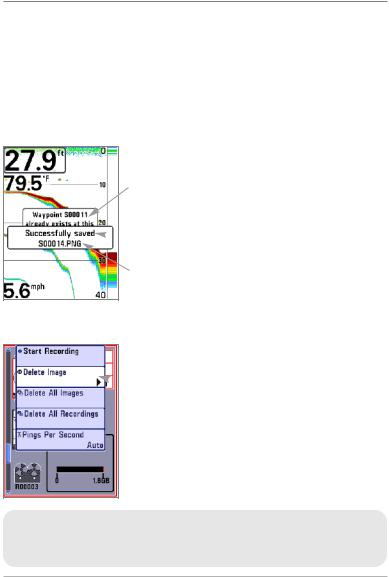
Screen Snapshots
Screen Snapshots are saved pictur es of the v iew on the screen. The screen snapshot will include the menus, dialog boxes, warnings, and messages that were active when the screen snapshot was taken. Saved Screen Snapshots can be viewed from the Snapshot and Recording View or Chart View.
The Screen Snapshot feature is available when an optional-purchase MMC/SD card is i nstalled and Screen Snaps hot is On (see Setup Men u Tab, Scre en Snapshot).
Make a Screen Snapshot |
Make a Screen Snapshot: |
Waypoint saved at Cursor Location
 Screen Snapshot
Screen Snapshot
Confirmation
File Name
Delete a Screen Snapshot
 From Snapshot and Recording View, select Delete Image from the X-Press™ Menu.
From Snapshot and Recording View, select Delete Image from the X-Press™ Menu.
1.Activate Scre en Sn apshot and install an MMC/SD card.
2.From any view or cursor location you w ant to capture, p ress the MARK key. The screen will pause while the image is saved.
A waypoint will also be created at the boat or active cursor loc ation. The screen sn apshot sh ares the same file name (.PNG).
Delete a Screen Snapshot:
1. From the Snapshot and Recording View, p ress th e UP or DOW N Cursor keys to scroll through the saved fil es a nd hi ghlight a snapshot file.
2.Press t he M enu k ey o nce, and select Delete I mage fr om t he X-Press™ Menu.
3.Press the RIGHT Cursor key.
NOTE: Navigation is not affected by the Screen Snapshot feature. Also, if Screen Snapshot is enabled, but a GPS receiver is not connected, pressing the MARK ke y will capture the screen image but an error will display that says a GPS position fixis requiredto create a waypoint.
Views
20
